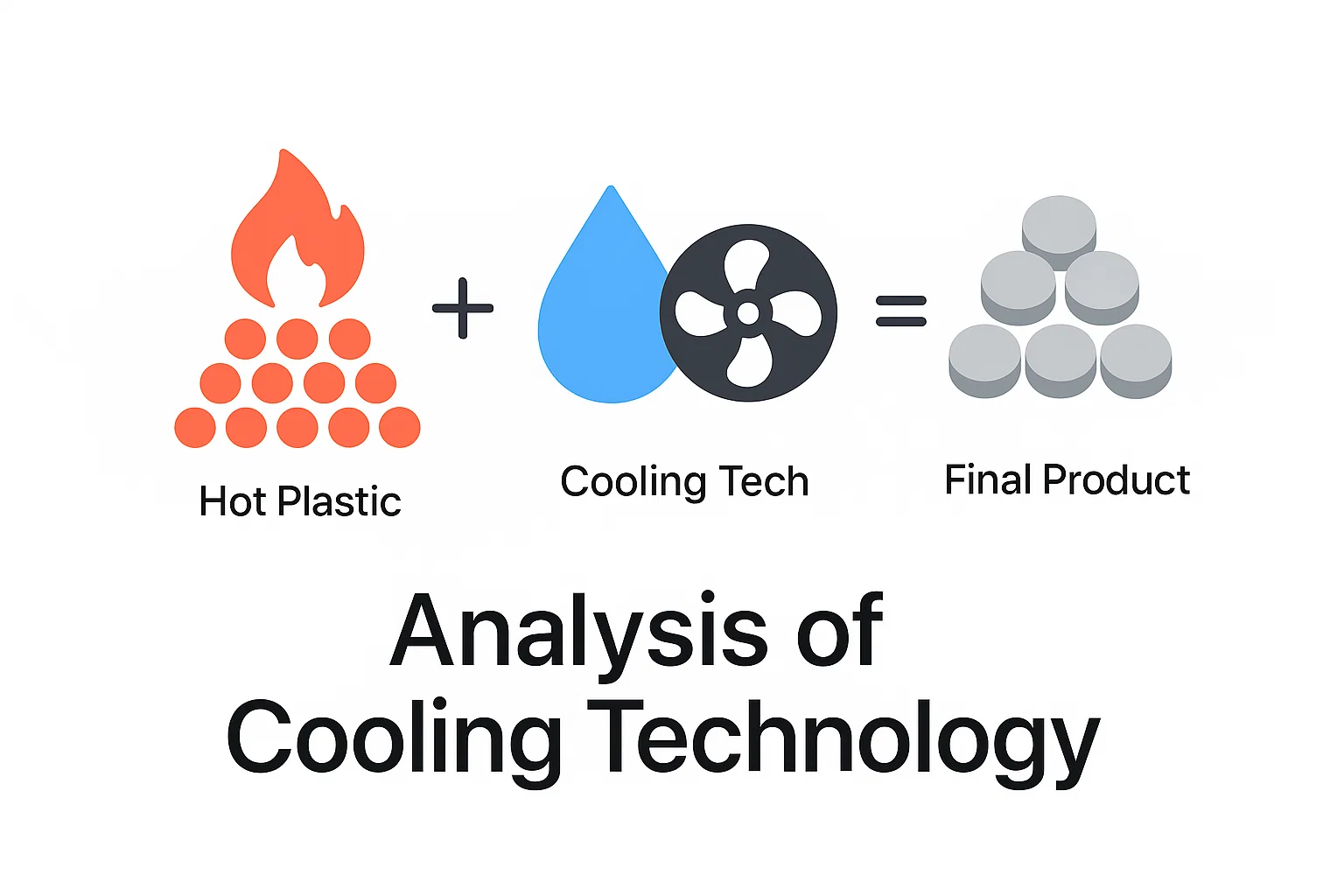In the world of plastic recycling, the journey from waste material to high-quality, reusable pellets is a testament to precision engineering. While the extruder and cutter of a Máquinas para máquinas de tratamiento de materias plásticas often take center stage, the cooling process that follows is equally critical. It is the silent, yet decisive, phase that dictates the final quality, consistency, and structural integrity of the plastic pellets.
At Rumtoo, we believe that an informed customer is an empowered partner. Understanding the nuances of cooling technology is fundamental to selecting the right equipment for your operational needs. This comprehensive analysis will explore the principles, methods, and key considerations of cooling within the plastic pelletizing process, providing industrial professionals with the insights needed to optimize their production and enhance their final product.
Why Cooling is a Critical Stage in Plastic Pelletizing
After molten plastic is extruded and cut into pellets, it is still in a hot, malleable state. The primary function of the cooling system is to rapidly and uniformly reduce the temperature of these pellets. This controlled heat extraction is crucial for several reasons:
- Structural Integrity: Proper cooling solidifies the polymer chains, giving the pellets their required hardness and durability. Inadequate or uneven cooling can lead to internal stresses, resulting in brittle or misshapen pellets.
- Pellet Morphology: The cooling rate directly influences the final shape and size of the pellets. A well-designed system prevents pellets from sticking together (agglomeration) and ensures a uniform, free-flowing product that is ideal for storage, transport, and subsequent processing.
- Crystallinity and Properties: For semi-crystalline polymers like PET and HDPE, the cooling rate affects the degree of crystallinity. This, in turn, influences key physical properties such as density, tensile strength, and optical clarity. The goal is to manage the transition from the melt temperature (Tmelt) to below the glass transition temperature (Tg) with absolute control.
Essentially, the cooling system is where the desired physical properties of the recycled plastic are locked in.
An Analysis of Key Cooling Technologies
Cooling systems in the plastic pelletizing industry primarily fall into two main categories: water cooling and air cooling. Each has distinct methods and is suited to different applications and polymer types.
1. Water Cooling Systems: The Industry Standard
Water’s high thermal conductivity makes it an exceptionally efficient medium for heat removal. This method is favored for its speed and its ability to handle high-throughput operations.
- Water Strand Cooling: This is a classic and widely used method. Molten plastic strands are extruded from the die head and drawn through a water bath or trough. The cooled, solidified strands are then fed into a pelletizer, which cuts them into uniform pellets.
- Best for: Commodity plastics like Polypropylene (PP) and Polyethylene (PE).
- Advantages: Simple design, cost-effective, easy to operate and maintain.
- Considerations: Requires a dewatering and drying system to remove residual moisture, which can add to the footprint and energy consumption.
- Peletización con anillos de agua: In this system, a rotating cutter slices the molten polymer as it exits the die face. The hot pellets are immediately thrown outwards into a circulating ring of water. The water cools and transports the pellets to a centrifugal dryer.
- Best for: High-volume production of non-hygroscopic materials.
- Advantages: Highly automated, compact design, produces uniform spherical or elliptical pellets.
- Considerations: Not ideal for moisture-sensitive plastics unless a highly efficient drying system is integrated.
- Underwater Pelletizing (UWP): As the name suggests, the cutting process happens directly at the die face, which is submerged in a chamber of flowing water. The pellets are cut and instantly solidified, then transported in the water slurry to a dryer.
- Best for: A wide range of polymers, including heat-sensitive and sticky materials like PET, Polystyrene (PS), and certain thermoplastic elastomers (TPEs).
- Advantages: Produces exceptionally uniform, high-quality pellets with minimal dust. The closed-loop system minimizes operator exposure to fumes.
- Considerations: This represents a higher initial investment and has greater mechanical complexity compared to strand systems.
2. Air Cooling Systems: The Specialist Choice
Air cooling is the preferred method for plastics that are highly sensitive to moisture, where even minimal residual water can compromise the material’s integrity during subsequent processing.
- Air-Cooled Pelletizing: In this setup, strands are extruded onto a conveyor belt, which is typically perforated. Fans blow ambient or chilled air over and through the strands to cool them before they reach the pelletizer.
- Best for: Highly hygroscopic (water-absorbing) polymers such as Polyamide (PA), Polycarbonate (PC), and certain grades of PET.
- Advantages: Eliminates the need for a drying stage, simplifying the process and reducing energy costs associated with moisture removal.
- Considerations: Cooling is significantly slower than with water, which limits the production throughput. The system also requires a larger footprint to allow for adequate cooling time on the conveyor.
Comparative Analysis: Water vs. Air Cooling
| La característica | Water Cooling Systems | Air Cooling Systems |
| Cooling Efficiency | Very High | Low to Moderate |
| Production Throughput | alto | baja |
| Calidad del Pellet | Excellent, very uniform (especially UWP) | Good, but can be less uniform |
| Ideal Plastics | PE, PP, PS, PET (UWP) | PA, PC, moisture-sensitive PET |
| Operational Costs | Moderado (tratamiento de agua y energía de secado) | Bajo (no es necesario secado) |
| Inversión inicial | Varía (baja para la cadena, alta para la UWP) | moderado |
| System Footprint | De compacto a moderado | grande |
| Key Advantage | Velocidad y alta capacidad de producción | Evita la contaminación por humedad |
¿Cómo seleccionar el sistema de refrigeración adecuado para su máquina de granulado de plástico
Elegir la tecnología de refrigeración correcta no es una decisión única. Esto requiere una evaluación cuidadosa de sus parámetros operativos específicos:
- Tipo de Material: ¿Es su materia prima primaria higroscópica? Si usted está procesando PA o PC, un sistema de refrigeración de aire es casi seguro que la mejor opción. Para poliolefinas estándar como PE y PP, un sistema de cadena de agua o de anillo de agua ofrece un excelente equilibrio entre coste y rendimiento.
- Rendimiento requerido: Para las plantas de reciclaje de alta capacidad, las rápidas tasas de enfriamiento de los sistemas a base de agua son esenciales para mantener el ritmo de las demandas de producción.
- Requisitos de calidad del Pellet Final: Si sus clientes demanpellets perfectamente esféricon cero multas, un pelletizsubmarino es una opción premium. Para aplicaciones de propósito general, la refrigeración de filamento a menudo es suficiente.
- Costos presupuestarios y operativos: Considere tanto el gasto de capital inicial y los costos de funcionamiento a largo plazo. Mientras que un sistema refrigerpor aire puede tener facturas de energía más bajas debido a la falta de un secador, su menor rendimiento podría afectar la rentabilidad general.
En Rumtoo, nuestro equipo técnico trabaja en estrecha colaboración con los clientes para analizar estos factores, garantizando la calidad de nuestros productos Máquinas para máquinas de tratamiento de materias plásticas Y su sistema de refrigeración integrado se adaptan perfectamente a sus objetivos de negocio.
Conclusión: el enfriamiento como piedra angular del valor
El sistema de refrigeración es mucho más que un accesorio a Máquinas para máquinas de tratamiento de materias plásticas; Es un componente fundamental que define el valor de su producto reciclado. El dominio de esta tecnología permite A los recicladores producir de forma consistente pellets de alta calidad que cumplen con las estrictas exigencias de la fabricación moderna.
Ya sea para usted la eficiencia de un sistema de anillo de agua, la precisión de un peletizador submarino o la aplicación especializada de refrigeración por aire, una elección informada es el primer paso para maximizar el retorno de su inversión.
Listo para mejorar sus capacidades de reciclaje de plástico? Póngase en contacto con los expertos de Rumtoo hoy. Permíque le ayudemos a navegar por las complejide la tecnología de refrigeración e idee una solución que ofrezca un rendimiento y una calidad sin precedentes.
Preguntas frecuentes (FAQs)
P1: ¿Cómo influye directamente el método de enfriamiento en la calidad de los pellets de plástico finales?
El método de enfriamiento influye en la morfodel pellet, la cristalinidad y la integridad estructural. Un enfriamiento rápido y uniforme (por ejemplo, granulado bajo agua) produce gránulos esférialtamente consistentes con baja tensión interna. Un enfriamiento más lento o desigual puede resultar en pellets deformes, aglomer, o quebradizos, lo que puede causar problemas en el procesamiento posterior.
P2: ¿Cuál es la diferencia típica en el costo operativo entre los sistemas de refrigeración de agua y aire?
En general, los sistemas de refrigeración por aire tienen menores costos operativos porque no requieren una unidad de deshidratación y secado, lo que permite un ahorro significativo de energía. Sin embargo, los sistemas de refrigeración por agua ofrecen un rendimiento mucho mayor. La solución más rentable depende de equilibrar el ahorro de energía con el volumen de producción. Los sistemas de cadenas de agua suelen ser los más económicos para plásticos de gran volumen no sensibles a la humedad.
P3: ¿Puede utilizarse un sistema de refrigeración para todo tipo de plásticos?
No, un solo sistema No es universalmente óptimo. La refrigeración por agua no es adecuada para plásticos altamente higroscópicos como el nylon (PA) sin un secado excepcional, ya que la retención de humedad arruinará el material. Por el contrario, la refrigeración por aire es demasiado lenta para la producción de gran volumen de plásticos básicos como PE y PP. La elección debe adaptarse al polímero específico que se está procesando.
P4: ¿Qué tipo de mantenimiento se requiere para los diferentes sistemas de refrigeración?
Los sistemas de refrigeración por agua requieren un mantenimiento regular de bombas de agua, filtros y sistemas de tratamiento para evitar la acumulación y contaminación de minerales. La unidad de secado (centrífuga o vibrante) también necesita controles de rutina. Los sistemas de refrigeración por aire son generalmente más simples, requimantenimiento principalmente para ventil, filtros y la cinta transportpara asegurar un flujo de aire y operación consistentes.

